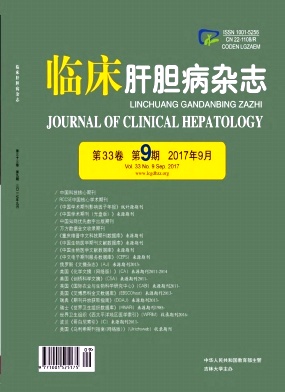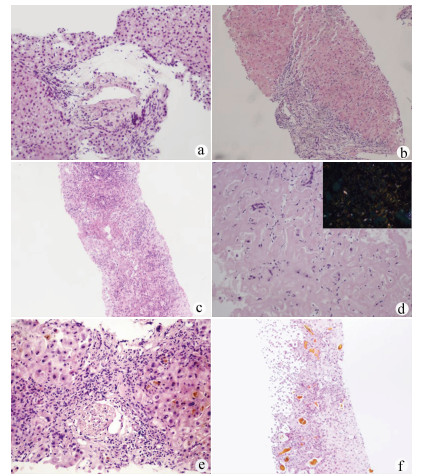|
[1]YE SL.Current challenges to primary liver cancer research[J].J Clin Hepatol, 2015, 31 (6) :819-823. (in Chinese) 叶胜龙.原发性肝癌研究当前面临的挑战[J].临床肝胆病杂志, 2015, 31 (6) :819-823.
|
|
[2]QIN N, YANG F, LI A, et al.Alterations of the human gut microbiome in liver cirrhosis[J].Nature, 2014, 513 (7516) :59-64.
|
|
[3]CHEN Y, YANG F, LU H, et al.Characterization of fecal microbial communities in patients with liver cirrhosis[J].Hepatology, 2011, 54 (2) :562-572.
|
|
[4]LU H, WU Z, XU W, et al.Intestinal microbiota was assessed in cirrhotic patients with hepatitis B virus infection.Intestinal microbiota of HBV cirrhotic patients[J].Microb Ecol, 2011, 61 (3) :693-703.
|
|
[5]Ministry of Health of the People's Republic of China.Diagnosis, management, and treatment of hepatocellular carcinoma (V2011) [J].J Clin Hepatol, 2011, 27 (11) :1141-1159. (in Chinese) 中华人民共和国卫生部.原发性肝癌诊疗规范 (2011年版) [J].临床肝胆病杂志, 2011, 27 (11) :1141-1159.
|
|
[6]CAPORASO JG, KUCZYNSKI J, STOMBAUGH J, et al.QIIME allows analysis of high-throughput community sequencing data[J].Nat Methods, 2010, 7 (5) :335-336.
|
|
[7]Greengenes.The greengenes database downloads[DB/OL].http://greengenes.secondgenome.com/downloads/database/13_5.
|
|
[8]TAO X, WANG N, QIN W.Gut Microbiota and Hepatocellular Carcinoma[J].Gastrointest Tumors, 2015, 2 (1) :33-40.
|
|
[9]QIN J, LI R, RAES J, et al.A human gut microbial gene catalogue established by metagenomic sequencing[J].Nature, 2010, 464 (7285) :59-65.
|
|
[10]MADSEN BS, HAVELUND T, KRAG A.Targeting the gut-liver axis in cirrhosis:antibiotics and non-selective beta-blockers[J].Adv Ther, 2013, 30 (7) :659-670.
|
|
[11]SUNG JY, SHAFFER EA, COSTERTON JW.Antibacterial activity of bile salts against common biliary pathogens.Effects of hydrophobicity of the molecule and in the presence of phospholipids[J].Dig Dis Sci, 1993, 38 (11) :2104-2112.
|
|
[12]GUNNARSDOTTIR SA, SADIK R, SHEV S, et al.Small intestinal motility disturbances and bacterial overgrowth in patients with liver cirrhosis and portal hypertension[J].Am J Gastroenterol, 2003, 98 (6) :1362-1370.
|
|
[13]WIEST R, LAWSON M, GEUKING M.Pathological bacterial translocation in liver cirrhosis[J].J Hepatol, 2014, 60 (1) :197-209.
|
|
[14]LI DY, YANG M, EDWARDS S, et al.Nonalcoholic fatty liver disease:for better or worse, blame the gut microbiota?[J].JPEN J Parenter Enteral Nutr, 2013, 37 (6) :787-793.
|
|
[15]SEKI E, de MINICIS S, OSTERREICHER CH, et al.TLR4 enhances TGF-beta signaling and hepatic fibrosis[J].Nat Med, 2007, 13 (11) :1324-1332.
|
|
[16]LOO TM, KAMACHI F, WATANABE Y, et al.Gut microbiota promotes obesity-associated liver cancer through PGE2-mediated suppression of antitumor immunity[J].Cancer Discov, 2017, 7 (5) :522-538
|
|
[17]BRANDI G, de LORENZO S, CANDELA M, et al.Microbiota, NASH, HCC and the potential role of probiotics[J].Carcinogenesis, 2017, 38 (3) :231-240.
|
|
[18]HUANG XF.The role of bile acid signaling in liver carcinogenesis and liver regeneration[D].Fuzhou:Fujian Med Univ, 2007. (in Chinese) 黄雄飞.胆酸信号与肝癌发生和肝脏再生[D].福州:福建医科大学, 2007.
|
|
[19]YOSHIMOTO S, LOO TM, ATARASHI K, et al.Obesity-induced gut microbial metabolite promotes liver cancer through senescence secretome[J].Nature, 2013, 499 (7456) :97-101.
|
|
[20]YU LX, YAN HX, LIU Q, et al.Endotoxin accumulation prevents carcinogen-induced apoptosis and promotes liver tumorigenesis in rodents[J].Hepatology, 2010, 52 (4) :1322-1333.
|
|
[21]DAPITO DH, MENCIN A, GWAK GY, et al.Promotion of hepatocellular carcinoma by the intestinal microbiota and TLR4[J].Cancer Cell, 2012, 21 (4) :504-516.
|
|
[22]ZHANG HL, YU LX, YANG W, et al.Profound impact of gut homeostasis on chemically-induced pro-tumorigenic inflammation and hepatocarcinogenesis in rats[J].J Hepatol, 2012, 57 (4) :803-812.
|
|
[23]MITSUOKA T.Bifidobacteria and their role in human health[J].J Ind Microbiol, 1990, 6 (4) :263-267.
|
|
[24]SHETH AA, GARCIA-TSAO G.Probiotics and liver disease[J].J Clin Gastroenterol, 2008, 42 (Suppl 2) :s80-s84.
|
|
[25]MALAGUARNERA M, GRECO F, BARONE G, et al.Bifidobacterium longum with fructo-oligosaccharide (FOS) treatment in minimal hepatic encephalopathy:a randomized, double-blind, placebo-controlled study[J].Dig Dis Sci, 2007, 52 (11) :3259-3265.
|
|
[26]ZHANG M, ZHENG M, WU Z, et al.Alteration of gut microbial community after N, N-Dimethylformamide exposure[J].J Toxicol Sci, 2017, 42 (2) :241-250.
|
|
[27]HE J, LIU J, KONG Y, et al.Serum activities of liver enzymes in workers exposed to sub-TLV levels of dimethylformamide[J].Int J Occup Med Environ Health, 2015, 28 (2) :395-398.
|
|
[28]KIM KW, CHUNG YH.Hepatotoxicity in rats treated with dimethylformamide or toluene or both[J].Toxicol Res, 2013, 29 (3) :187-193.
|
|
[29]LIU HX, ROCHA CS, DANDEKAR S, et al.Functional analysis of the relationship between intestinal microbiota and the expression of hepatic genes and pathways during the course of liver regeneration[J].J Hepatol, 2016, 64 (3) :641-650.
|
|
[30]ISLAM KB, FUKIYA S, HAGIO M, et al.Bile acid is a host factor that regulates the composition of the cecal microbiota in rats[J].Gastroenterology, 2011, 141 (5) :1773-1781.
|
|
[31]RIDLON JM, ALVES JM, HYLEMON PB, et al.Cirrhosis, bile acids and gut microbiota:unraveling a complex relationship[J].Gut Microbes, 2013, 4 (5) :382-387.
|
|
[32]GRAT M, WRONKA KM, KRASNODEBSKI M, et al.Profile of gut microbiota associated with the presence of hepatocellular cancer in patients with liver cirrhosis[J].Transplant Proc, 2016, 48 (5) :1687-1691.
|








 下载:
下载:







 DownLoad:
DownLoad: